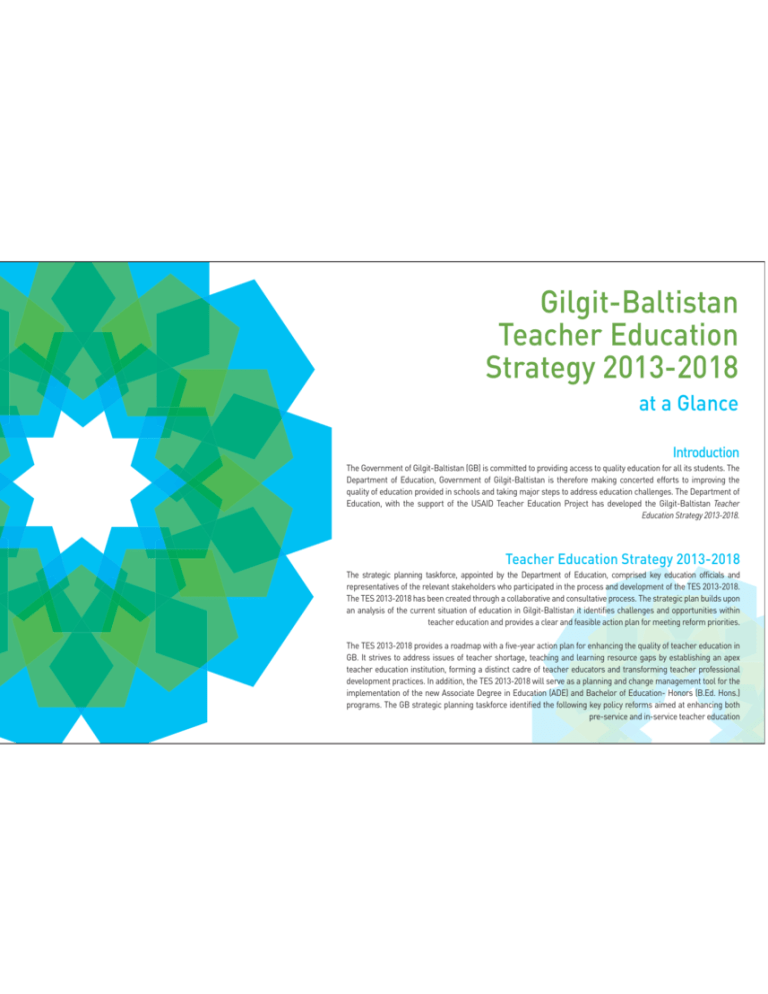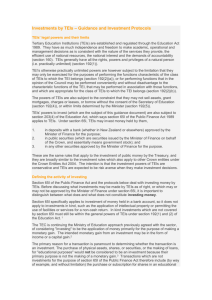GB summary final - Knowledge Portal
advertisement

Gilgit-Baltistan Teacher Education Strategy 2013-2018 at a Glance Introduction The Government of Gilgit-Baltistan (GB) is committed to providing access to quality education for all its students. The Department of Education, Government of Gilgit-Baltistan is therefore making concerted efforts to improving the quality of education provided in schools and taking major steps to address education challenges. The Department of Education, with the support of the USAID Teacher Education Project has developed the Gilgit-Baltistan Teacher Education Strategy 2013-2018. Teacher Education Strategy 2013-2018 The strategic planning taskforce, appointed by the Department of Education, comprised key education officials and representatives of the relevant stakeholders who participated in the process and development of the TES 2013-2018. The TES 2013-2018 has been created through a collaborative and consultative process. The strategic plan builds upon an analysis of the current situation of education in Gilgit-Baltistan it identifies challenges and opportunities within teacher education and provides a clear and feasible action plan for meeting reform priorities. The TES 2013-2018 provides a roadmap with a five-year action plan for enhancing the quality of teacher education in GB. It strives to address issues of teacher shortage, teaching and learning resource gaps by establishing an apex teacher education institution, forming a distinct cadre of teacher educators and transforming teacher professional development practices. In addition, the TES 2013-2018 will serve as a planning and change management tool for the implementation of the new Associate Degree in Education (ADE) and Bachelor of Education- Honors (B.Ed. Hons.) programs. The GB strategic planning taskforce identified the following key policy reforms aimed at enhancing both pre-service and in-service teacher education Gilgit-Baltistan Teacher Education Strategy 2013-2018 at a Glance Policy Reforms Reform 1: Establish an Apex Teacher Education Institution In order to manage the growing teacher education system, there is a need to establish a support institution at the provincial level. Reform 2: Create a Separate Cadre for Teacher Education Institution (TEI) Faculty Creating a separate cadre for teacher education faculty and establishing the separate Directorate for Staff Development will bring creditable teacher education standards to GB and highly qualified teacher educators to its institutions. Reform 3: Strengthen Teacher Education Institutions To promote a quality learning and teaching environment, it is necessary to renovate and upgrade facilities and course content and curricula at all TEIs in GB. Reform 4: Address the Teacher Shortage in Schools To ensure that quality teachers are in each and every classroom in GB, there is an urgent need to efficiently and effectively recruit and deploy qualified teachers and subsequently provide them with a fair salary package. Reform 5: Establish a Quality Monitoring Cell To maintain high standards of education in GB and to ensure that all teachers are teaching and students are learning, it is necessary to develop an effective quality assurance mechanism. Reform 6: Rationalize TEI Faculty Recruitment It is crucial to maintain the appropriate number of faculty at each TEI. In addition, faculty whose skills and qualifications align with the needs of the new courses introduced in TEIs as well as the National Professional Standards for Teachers (NPSTs) need to be recruited. Reform 7: Provide Information and Communication Technology (ICT) Facilities to the Teacher Education Colleges To keep apace with the ever changing trends in education, there is need to equip TEIs with adequate ICT facilities. Strategies 1.1. Restructure the domains of teacher education, curriculum and research to be led and managed by the Director of Staff Development (DSD) 1.2. Upgrade the current profile of teacher education, curriculum and research and take concrete steps to improve the significance in these areas Strategies 2.1. Create a career path for and increase the professionalism of TEI faculty 2.2. Find short-term and long-term solutions to address the teacher education college faculty issues, such as placement and course-load allocation 1.3. Increase the provision of human and financial resources to revitalize the domains of teacher education, curriculum and research 2.3. Upgrade the profile of teacher education college faculty in GB Strategies 3.1. Address infrastructure-related challenges, especially classroom space and washroom issues 3.2. Provide the necessary resources for a quality learning environment at all TEIs for faculty and students Strategies 4.1. Rationalize teacher distribution in schools and identify schools with surplus teachers 3.3. Improve the quality of teacher education programs by increasing their relevance to the teachers’ content and pedagogical needs 4.2. Identify and address teachers’ salary issues and concerns Strategies 5.1. Develop measurable quality indicators for teaching and learning processes in schools and in teacher education institutions 5.2. Introduce quality-monitoring mechanisms (including reporting formats and user-friendly software) for schools and teacher education colleges and collect and analyze the data on a monthly, quarterly and yearly basis Strategies 6.1. Hire an adequate number of faculty for each TEI 6.2. Recruit faculty with subject specializations 5.3. Create an organizational culture for quality improvement, specifically linking incentives with performance 6.3. Implement short-term and long-term faculty development plans Strategies 7.1. Introduce faster and more modern methods of communication within and between the colleges 7.2. Equip colleges with Internet connectivity 7.2. Computerize college records Reform 8: Improve the Coordination between Karakorum International University (KIU) and TEIs Enhancing the frequency and quality of coordination between KIU and TEIs as well as other education institutions is essential in bridging communication gaps and improving collaboration in teacher education. Reform 9: Establish District-Based Units to Support TEI Faculty There is a great need to develop a system in GB that will provide school-based regular professional support to teachers and their managers. Reform 10: Advocate for Legislation on Various Education Reform Issues To promote quality education in GB and engage students and prospective teachers, it is imperative to expand awareness of education issues and achievements. Strategies 8.1. Schedule regular opportunities for information-sharing between KIU and other TEIs 8.2. Promote frequent exchange of knowledge and experiences among TEIs 8.3. Clarify standards and expectations for NACTE-accredited teacher education programs to college faculty and students Strategies 9.1. Provide frequent and ongoing professional development support to teachers in their schools 9.2. Conduct training needs analyses in schools and share findings with teacher education colleges to aid the design of relevant and meaningful courses 9.3. Hold continuous professional development (CPD) courses in schools or at cluster-levels to cater to practicing teachers Strategies 10.1. Develop socio-political consensus on potential policy shifts 10.2. Secure the GB Legislative Assembly’s endorsement in order to shield policy changes from any unforeseen legal implications Department of Education Government of Gilgit-Baltistan 10.3. Ensure that policy changes are legally-binding for all stakeholders







